Anti Christ means "Instead of Christ" or "In place of Christ"
(Greek, anti = "instead of" or "in place of")
Norbert Kox's Apocalyptic Surrealism
Apocalypse House Homepage

"All the World Wondered after the Beast" (Rev.13:3). Satan has duped the people of the world into mistranslating and distorting the Word of God, to create a false gospel, a false image of the Saviour, and a false name: the mark of the Beast (Rev. 13:18). The Devil said "I will be like the Most High." He is the imitation God, and the "idol shepherd".

Jesus the Antichrist: Who Changed God's Name? (WARNING).
Disclaimer
This is not a hate site. It is a site that challenges traditions and exposes falsehoods. This site is not anti-christ. This site does not present anti-Catholic material. It presents factual information. It exposes counterfeits and dupes in regard to religious and biblical interpretation, whether Catholic, Protestant, Jewish, Moslem, Hindu, Buddhist, Athiest, Satanist, New Age, or any other religion, non-religion, or philosophy.
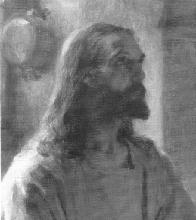
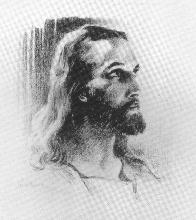
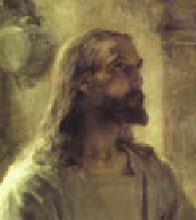

Leon Lhermitte, 1892
Leon Lhermitte, 1892
Warner Sallman, 1924
Warner Sallman, 1940
"Friend of the Humble" [Emmaus]
(detail)
"Son of Man"
"Friend of the Humble" [Emmaus]
(detail)
"Head of Christ"
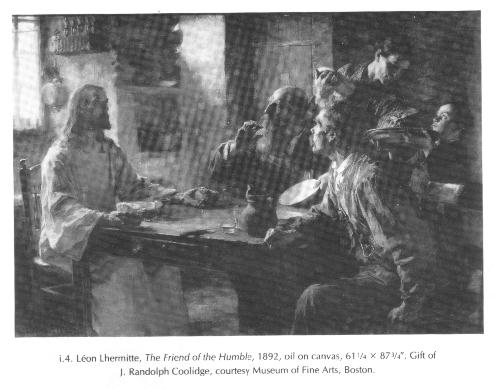
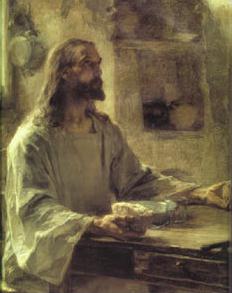
"Friend of the Humble" (detail)
Leon Lhermitte, 1892
Leon Lhermitte painted "Friend of the Humble" in 1892. Warner Sallman was born in 1892. Leon Lhermitte's painting appeared in Lady's Home Journal, in 1921. Sallman cut out the head of Christ from the reproduction and framed it for his mother. In 1924, when he painted "Son of Man," precurssor to "Head of Christ," was it from an apparition, or from the head he had cropped from Lhermitte's picture?
Compare the lay of the hair, the back-lighting on the hair, the hilighting of the forehead, eyebrow, and cheekbone, the shape of the beard, shadows on the neck, and the folds in the robe. Can there be any doubt where Sallman got his "vision"? Was Warner Sallman a visionary, or a thief and a liar?
Is the so-called "Head of Christ" a portrait of the Saviour, or the Image of the Beast?
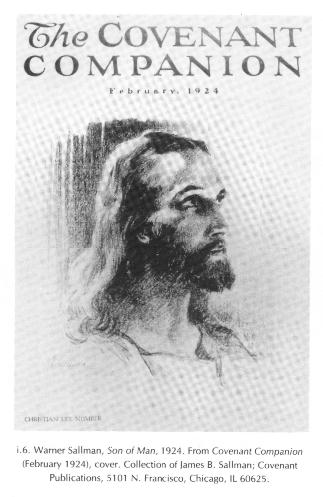
The inhabitants of the world wanted an image to worship. Warner Sallman just happened to be the one cursed to produce that image, all-be-it a plagiarized image. Sallman was given the knowledge and means to seduce the masses of the earth's population, to give life [from Greek, "a spirit"] to the image [Revelation 13: 14-15]. The Lhermitte image lacked this "spirit," which the Sallman head was given. The Sallman head was a reborn or revived image, a relative or descendant of the former. People believed Sallman's lie of Divine inspiration and revered the image to such an extent that they gave power unto it. They began to pray to it and trust in it as the living "Jesus." People began seeing apparitions of the man in the image, further validating it. During World War II every American soldier was given a wallet-size card of "The Head of Christ" to carry with him into battle.
A member of the Methodist clergy noted how he and a friend in boot camp during World War II were struck by the Head of Christ, particularly by "its beauty and its meaning and its power to attract our attention" (22). Many found that the image commanded their attention in a way that required a personal response: "More than once I was completely captivated by the painting. Seems I could sit and look at it for the longest [time]" (71). A woman who "gave [her] life to Christ" while watching Sallman create his image at a chalk talk said, "When I look at it. . . I am reminded that Jesus Christ is my Lord and Savior. He died for me. Am I able to give my life for Him?" (63). Another woman wrote that the images "bring me close to my Saviour and Friend" (92). Many respondents found the notion of a friendly Christ important. As one man put it, "It's the Jesus that I love and know above all things, he's my friend. I can walk and talk with him. I know he cares for me and my family. And best of all he's real and alive" [Icons of American Protestantism: THE ART OF WARNER SALLMAN, p.194]
Nearly everyone who admires Sallman's depictions of Christ, all of which are based on the original drawing of 1924 and its 1940 rendition in oil, says that these pictures look like Jesus.
...a small number of respondents report that they have seen Jesus and that he resembles Sallman's rendition of him, most qualify in some way the assertion of a simple resemblance. Yet many seem quite assured that this picture looks like Jesus. ..."To me, looking at this picture brings me a peace of mind. It's hard to explain why I like it so much. I guess I picture Christ to look just as he does in this picture" (333).3 For a great number of respondents, Sallman's Head of Christ is an optically correct or accurate image of the historical individual, Jesus of Nazareth. One person went so far as to say that for her the "picture is a true photo of Jesus" [Icons of American Protestantism: THE ART OF WARNER SALLMAN, p.183]
...another Anglo-Saxon respondent ..."I have seen many pictures of Jesus, but I always believed that Sallman's portrait of Jesus was the one that looked most like Jesus really looked when here on earth"...the narrative was understood to authenticate Sallman's images as a genuine representation, even a literal transcription, of Christ's appearance. [Icons of American Protestantism: THE ART OF WARNER SALLMAN, p.184]
"And there was given to it to give a spirit to the image of the beast, so that the image of the beast might both speak, and might cause as many as would not worship the image of the beast to be killed."
(Revelation 13:15, Modern King James Version)
"And he had power, to give life unto the image of the beast, that the image of the beast should both speak, and cause that as many as, would not worship the image of the beast should be killed.
(Revelation 13:15, King James Version)
1
1
2
2
3
3
The counterfeit JESUS = 666
"Friend of the Humble"